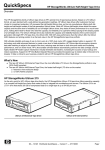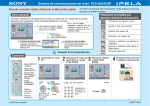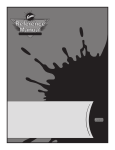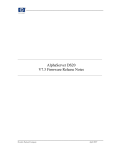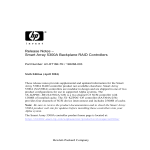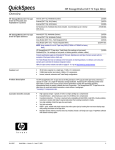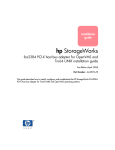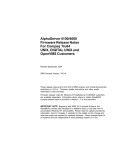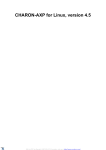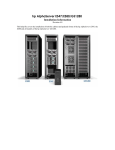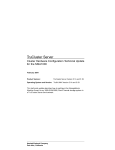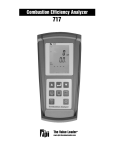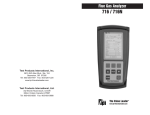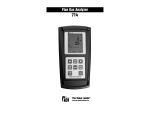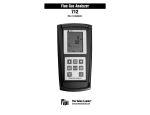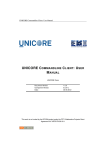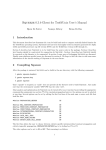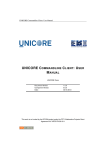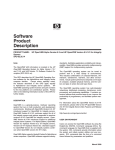Download AlphaServer DS15, DS15A Console Firmware Release Notes V7.3
Transcript
Revised: February 27, 2008 AlphaServer DS15, DS15A Console Firmware Release Notes V7.3 This document contains firmware enhancements and update procedures. Start with Read Me First Hewlett-Packard Company The information in this publication is subject to change without notice. Copyright © 2005-2008 Hewlett-Packard Company HP shall not be liable for technical or editorial errors or omissions contained herein, nor for incidental or consequential damages resulting from furnishing, performance, or use of this material. This is provided “as is” and HP disclaims any warranties, express, implied or statutory and expressly disclaims the implied warranties or merchantability, fitness for particular purpose, good title and against infringement. COMPAQ, the Compaq logo, DEC, the DEC logo, AlphaStation, AlphaServer, and VMS Registered in the U.S. Patent and Trademark Office. OpenVMS, Tru64 are trademarks of Compaq Information Technologies Group, L.P. in the United States and/or other countries. UNIX is a trademark of The Open Group in the United States and/or other countries. All other product names mentioned herein may be trademarks or registered trademarks of their respective companies. Compaq Computer Corporation is a wholly owned subsidiary of the Hewlett-Packard Company. The information in this publication is subject to change without notice. 2 AlphaServer DS15, DS15A Console Firmware Release Notes V7.3 Scope ................................................................................................................................4 Golden Rules .................................................................................................................4 References ..................................................................................................................4 Read Me First...................................................................................................................5 Changes This Release ...................................................................................................5 Console and OS Revisions .........................................................................................6 I/O Adapter Firmware Revisions ...............................................................................6 Firmware Update Procedure ............................................................................................7 Update Firmware from CD ...........................................................................................7 The Loadable Firmware Utility.....................................................................................8 List Command ............................................................................................................8 Update Command.......................................................................................................8 Using the FailSafe Loader................................................................................................9 Restoring Firmware....................................................................................................9 Helpful Hints..................................................................................................................10 User Defined Environment Variables .........................................................................10 user_def1 and user_def2...........................................................................................10 Kgpsa...........................................................................................................................10 FRU Table Flags .........................................................................................................10 Clearing Error Flags .................................................................................................10 Known Anomalies and Restrictions............................................................................... 11 DVD Media .................................................................................................................11 Bootable DVD’s .......................................................................................................11 Console Command Sequences ....................................................................................11 Halt Button, Crash Command and Continue Command ..........................................11 Kzpea Notes ................................................................................................................12 Powering Up Attached Storage ................................................................................12 Missing BUS Termination Jumpers Can Hang Console ..........................................12 Mouse and Keyboard ..................................................................................................12 Do Not Hot Swap .....................................................................................................12 Fibre Channel Notes....................................................................................................12 Kgpsa Driver Startup Messages ...............................................................................12 MBX Not Ready.......................................................................................................13 WWIDMGR - No Unit Number Specified ..............................................................14 KVM Console Switch .................................................................................................14 Limitations with the Run Bios Command................................................................14 Firmware Change History ..............................................................................................15 V7.2 .............................................................................................................................15 V7.1 .............................................................................................................................15 V7.0 .............................................................................................................................15 3 Scope Scope The document lists significant changes in this firmware release and describes methods to update console firmware. It does not describe console firmware internals or console architecture. This document is intended for persons responsible for operating system installation upgrades and for console firmware and console-supported I/O option firmware updates. Golden Rules Update all console firmware before installing or updating an operating system to ensure compatibility. Console firmware for this server consists of SRM, FSB, RMC, SROM, and TIG firmware. Ensure firmware is updated to the latest revision level. AlphaServer systems recently shipped may have a higher console firmware revision than the firmware revision listed in this release. A higher firmware revision normally indicates support for the installed operating system. It is not recommended to load firmware that is older than what is presently installed. References Owner’s Guide Order Number: EK-DS150-OG.B01 Service Manual Order Number: EK-DS150-SV.B01 Firmware Main Page http://www.hp.com, click on Large Enterprise Business, click on Server, click on HP AlphaServer Systems, click on firmware Alpha Systems Support http://h20000.www2.hp.com/bizsupport/TechSupport/ Home.jsp http://www1.itrc.hp.com/service/home/home.do hp Alpha Retain Trust Program The hp Alpha Retain Trust Program underscores HP’s commitment to providing longterm business continuity for Alpha Systems customers. The program eases the evolution of moving from the Alpha platform to Itanium® architecture-based HP systems by ensuring HP carries forward the trust you have placed in us. It is focused on showing you the business value of moving forward with HP as a company, and mitigating the risk associated with transitions to future HP technologies. 4 Read Me First Read Me First Changes This Release V7.3 firmware was released to CD in April 2007. Since then, I/O option firmware for the KZPEC has been updated. This firmware is available in the firmware .iso image that is downloadable from the firmware website. Keyboard driver - a USB keyboard attached to a USB-to-PS2 adapter can sometimes hang when attempting to login for the first time on OpenVMS. Solution: Read the keyboard data and status registers immediately after enabling keyboard interrupts in order to drain any interrupts from the device. Kgpsa driver - on certain new Brocade fibre-channel switches, the console can fail to login to the fabric switch port if the connection is moved from one switch port to another. Solution: When attempting to login to a fibre-channel switch port, use an SDID of zero and the switch will provide the new SDID to the host adapter. Wwidmgr - the console supports a number of environmental variables to facilitate boot and crash dump to fibre-channel storage volumes. Presently there are four (4) WWIDx variables that define the world-wide-ID of a storage volume and eight (8) Nx variables that define the path to the storage volumes. The console uses these variables to define the volumes used for boot or crash dump devices. Solution: Increase variables Nx to 16 and WWIDx to 8 I/O Option Firmware - no changes 5 Read Me First Console and OS Revisions Operating System OpenVMS V8.2 Tru64 Unix V5.1B PalCode OpenVMS V1.98-7 Tru64Unix Console Firmware SRM V7.3-2 * FSB V7.3-3 * RMC Booter V1.1-0 RMC Runtime V1.2-0 SROM Extended (Flash) V1.0-1 TIG V1.11 SROM FailSafe (Non-Flashable) V1.0-0 An asterisk * indicates a firmware change since the previous release. I/O Adapter Firmware Revisions The following table list the firmware revision of I/O adapters that are updatable from the loadable firmware utility. There were no I/O adapter firmware changes this release. I/O Adapter Revision Notes Defpa 3.20 DS-KGPSA-DA 3.93a0 LP9002 DS-A5132-AA 1.91X6 LP10000 DS-A5134-AA 1.91X6 LP10000DC KZPDC 3.56 KZPEC 2.58 on CD Revision 2.76 became available after the firmware CD release. To get this version, download the.iso image from the firmware page and create a bootable CD. Boot the CD to invoke the LFU, then update the I/O firmware. An asterisk * indicates firmware changed since the previous console release. 6 Firmware Update Procedure Firmware Update Procedure The firmware update procedure uses the loadable firmware utility [LFU] to update firmware. The LFU is invoked by booting the Alpha Systems Firmware CD. If you don’t have the CD, you can create a bootable firmware CD by downloading the.iso image from the firmware web site. Updating firmware from DVD is not supported. Update Firmware from CD 1. Insert firmware CD in the CD drive. 2. Boot the CD - type boot dqa0. Booting invokes a program which determines the system model and then displays the default bootfile for that system model. 3. Press the Enter key after the “Bootfile:” prompt to invoke the LFU. 4. If RMC or TIG firmware has changed - type exit after the UPD> prompt, otherwise go to step 6. 5. Type Y or yes to switch to LFU Manual update mode. This mode allows updating RMC and TIG firmware. 6. Type the update command to update firmware. 7. Type yes to confirm updating firmware. 8. Type exit to leave the LFU. Exiting loads the firmware into flash and returns to the SRM console prompt. A power cycle is required only of TIG firmware has been updated to a newer version. 7 Firmware Update Procedure The Loadable Firmware Utility The LFU has a default and a manual update mode. Default mode can update SRM console, Fail-Safe Booter (FSB) RMC Runtime(rt), SROM, and I/O option firmware. Manual update mode will update all firmware except booter firmware. Note that booter firmware cannot be updated. List Command The list command displays the memory-loaded firmware images and supported flash ROM’s (shown in the Device column). UPD> list Device Current Revision Filename Update Revision FSB SRM booter pya0 rt srom tig V7.2-3 V7.3-2 V1.1-0 2.58 V1.2-0 V1.0-1 1.11 fsb_fw srm_fw booter_fw sa64xx_fw rt_fw srom_fw tig_fw dfxaa_fw fca_2354_fw fca_2384_fw fca_2684_fw kzpdc_fw V7.3-3 V7.3-2 No Update Available 2.58 V1.2-0 V1.0-1 1.11 3.20 CS3.93A0 HS1.91X6 TS1.91X6 3.56 UPD> Update Command The update command loads firmware into the device. The example show updating firmware in LFU manual mode. FIGURE 1. Update Command - Manual Mode UPD> exit Do you want to do a manual update [y/(n)]? y UPD> update Confirm update on: FSB SRM booter pya0 rt srom 8 Using the FailSafe Loader tig [Y/(N)] y WARNING: updates may take several minutes to complete for each device. DO NOT ABORT! FSB Updating to V7.3-3... Verifying V7.3-3... PASSED. SRM Updating to V7.3-2... Verifying V7.3-2... PASSED. booter No Update Available rt Updating to V1.2-0... Verifying V1.2-0... PASSED. srom Updating to V1.0-1... Verifying V1.0-1... PASSED. tig Updating to 1.11... Verifying 1.11... PASSED. UPD> exit An AC power cycle is required only if TIG firmware has been updated to a newer version., (i.e. turn off the system, remove external power, wait three seconds, then restore power) Using the FailSafe Loader The fail-safe loader (FSB) is a boot console utility used to recover from possible console firmware corruption (e.g. checksum ROM error). It is a smaller version of the SRM console and only contains device support for the inboard I/O controllers and supported Ethernet controllers. The FSB does not execute the power-up self-test script, but it does prompt to use the LFU utility to recover the SRM console image. The FSB can be invoked automatically or manually (with jumpers) after system power on. The FSB automatically boots when the SROM detects corruption in the SRM console flashrom image The FSB is manually booted if jumper J8 is in position 1-2 on the system motherboard. System power-on invokes the console SROM to load the FSB console from the system flashrom. Restoring Firmware To restore firmware from the FSB SRM prompt, do the following: 1. Boot the Alpha Firmware CD, or other bootable medium to invoke the LFU 2. Update firmware in LFU manual mode, exit the LFU, power down the system and move the FSB jumper back to its default position (if applicable). Make sure to move the jumper J8 to its original default position. 9 Helpful Hints Helpful Hints User Defined Environment Variables user_def1 and user_def2 Starting with the V7.0 firmware release, environment variables user_def1 and user_der2 were added for customer use. They are non-volatile environment variables that are readable and writable from the SRM console and accessible the Tru64 operating system. Format P00>>> set user_def<1 or 2> “any character string” SRM console P00>>> set user_def1 “asset no.1234 system location: green zone” example Tru64UNIX console example # consver -g user_def1 user_def1 = System_Asset_No: 1234, System_Location: green-zone Only a limited set of console environment variables are accessible from operating system. Kgpsa Informational Messages Kgpsa device messages, similar to “retry ct pga0.0.0.2.6”, are informational messages only. Retry messages, of this type, result from a device trying to gain access to a busy fibre channel switch. Device access is rejected, which causes the device to retry accessing the switch. Reconfiguring Fibre Channel Switches To ensure access from a fibre channel switch, a console init command is required if a fibre channel cable is moved from one port to another or if it has been removed and replaced. FRU Table Flags Clearing Error Flags To clear FRU-table error flags, use the following sequence of commands after the console prompt >>>. 10 1. Display the fru table to list any error flags. >>> show fru 2. Record the system serial number [ssn] >>> show sys_serial_num 3. Clear ssn >>> set sys_serial_num ““ 4. Clear error >>> clear_error all 5. Restore ssn >>> set sys_serial_number nnnnnnnnnn Known Anomalies and Restrictions Known Anomalies and Restrictions DVD Media Bootable DVD’s Bootable DVD's are not supported on all Alpha systems because of a limited memory size architectural restriction. Console Command Sequences Halt Button, Crash Command and Continue Command When the console is in graphics mode, the sequence of pressing the Halt button followed by typing the crash command then the continue command will not work, and cause different behaviors as described below. Command Sequence Behavior in an OpenVMS Environment Environment: OpenVMS with DW-Motif enabled, SRM console set to graphics mode, and graphics card installed. Symptom: Pressing the HALT button puts the graphics monitor to a frozen state. You must reset the system to clear this state. Use one of the following solutions to prevent getting into this state. Solution1: Set console to serial mode before booting the operating system. Solution2: Disable DW-MOTIF before pressing the HALT button using the following sequence. 1. Login to OS if you are not already logged in. 2. At the OpenVMS prompt, type: STOP DECW$SERVER_0 3. Press and release the HALT Button (if configured for HALT) to SRM console prompt. 4. Type crash 5. Reset the system and reboot the operating system. or 6. Continue and resume your DW-MOTIF session by issuing @sys$startup:decw$startup, then log out to bring up the DW-MOTIF session. Command Sequence Behavior in a Tru64UNIX Environment The Tru64Unix environment includes X11 enabled, SRM console set to graphics mode, and a graphics card installed. The symptom occurs when pressing the HALT button, (if configured for HALT), which puts the graphics monitor to a frozen state. You must reset the system to clear this state. 11 Known Anomalies and Restrictions Solution1: Set console to serial mode before booting the operating system. Solution2: Disable X11 before pressing the HALT button (if configured for HALT) 1. Login to OS if you are not already logged in. Kzpea Notes 2. Stop X11 by issuing the stop command (#/sbin/init.d/xlogin stop) 3. Press and release the HALT Button (if configured for HALT) to get to SRM console prompt 4. Type the crash command. 5. Reset the system then reboot the operating system. This section describes the behaviors with this controller under certain conditions. Powering Up Attached Storage When in console mode, use the init command after powering up a storage device attached to a KZPEA controller. The init command is not necessary when the storage device is powered up at the same time as the rest of the system or when the storage device is powered up with the operating system is already running. Missing BUS Termination Jumpers Can Hang Console The KZPEA-DB requires both SCSI buses to be terminated at both ends of the bus to prevent signal degradation. Signal degradation may result in the console hanging when trying to probe the controller for information. Verify that the termination jumpers, (J3 and J5) on the host adapter, are installed to enable termination on both channels. Mouse and Keyboard Do Not Hot Swap Do not hot swap the mouse or keyboard with power on. Disconnecting them with power on may cause electronic damage to the transceivers. Ensure power is off before swapping them. If the system is in console graphics mode, removing the mouse prevents any response from the keyboard, until the mouse is plugged back into the system. Fibre Channel Notes Kgpsa Driver Startup Messages When the console Kgpsa fiber channel driver starts up, you may see the message, "pga0.0.0.2.4 - Nvram read failed". The message indicates the KGPSA's NVRAM is either un-formatted or is not working properly. The more likely reason is an un-formatted NVRAM. The console contains a portion of the NVRAM to indicate if the adapter should be initialized to either a Fabric topology (when connected to a Switch) or should be initialized 12 Known Anomalies and Restrictions to a Loop topology. By default, the console initializes the KGPSA to a Fabric topology. The NVRAM is automatically formatted when the topology is set. For more information refer to the wwidmgr user’s manual. NVRAM Read Failed Message Example >>>wwidmgr -show ada item adapter WWN Cur. Topo Next Topo pga0.0.0.8.1 - Nvram read failed. [0] pga0.0.0.8.1 1000-0000-c920-05ab FABRIC UNAVAIL FABRIC UNAVAIL pgb0.0.0.10.1 - Nvram read failed. [1] pgb0.0.0.10.1 1000-0000-c921-0ce0 [9999] All of the above. >>>wwidmgr -set adapter -item 9999 -topo fabric pga0.0.0.8.1 - Nvram read failed. Reformatting nvram pgb0.0.0.10.1 - Nvram read failed. Reformatting nvram >>>wwidmgr -show ada item adapter WWN Cur. Topo Next Topo [0] pga0.0.0.8.1 1000-0000-c920-05ab FABRIC [1] pgb0.0.0.10.1 1000-0000-c921-0ce0 FABRIC [9999] All of the above. >>>init MBX Not Ready You may see a "*** MBX not ready ***" message when first formatting the NVRAM with the "wwidmgr -set ada" command. Reissuing this command should succeed without this message. >>>wwidmgr -set ada -item 9999 -topo fab pga0.0.0.6.1 - Nvram read failed. Reformatting nvram *** MBX not ready *** pgb0.0.0.1.2 - Nvram read failed. Reformatting nvram >>>wwidmgr -show ada item adapter WWN Cur. Topo Next Topo *** MBX not ready *** pga0.0.0.6.1 - Nvram format incorrect. [0] pga0.0.0.6.1 1000-0000-c920-a763 FABRIC UNAVAIL 13 Known Anomalies and Restrictions [1] pgb0.0.0.1.2 1000-0000-c920-c9fe FABRIC [9999] All of the above. >>>wwidmgr -set ada -item 9999 -topo fab >>>wwidmgr -show ada item adapter WWN Cur. Topo Next Topo [0] pga0.0.0.6.1 1000-0000-c920-a763 FABRIC [1] pgb0.0.0.1.2 1000-0000-c920-c9fe FABRIC [9999] All of the above. WWIDMGR - No Unit Number Specified The command "wwidmgr -quickset -item <n>" MUST also have the "-unit" qualifier on the line.The correct format for the command is as follows: >>> wwidmgr -quickset -item <n> -unit <n> If no unit number is specified, the console generates one that is a hashed value of the WWID. For more information refer to the wwidmgr user’s manual. KVM Console Switch Limitations with the Run Bios Command The SRM “run bios” command in not supported when a graphics console is connected through the KVM console switch, and will result in unexpected keyboard behavior. As a workaround, use the SRM “run bios” command from the serial console using a serial port connection to the COM1 port. 14 Firmware Change History Firmware Change History V7.2 Console Enhancements • Added RoHS part numbers in FRU tree • New module naming for I/O devices DE602-FA/FB is now DE602-F*, DEGXA-SB/ TB is now DEGXA-S*/T* • WWIDMGR rule added - do not attempt to get a UDID on a Fibre Channel SAN for SCSI sequential access or SCSI media changer type devices (i.e. tape drives, robot arms) V7.1 Console Enhancements • RMC runtime firmware updated to recognize DS15A systems • Increased the Adaptec SCSI support driver number of support targets from 16 to 32 • KGPSA driver changed to do faster retry on PLOGI frames • Changes to SCSI driver code to enhance page and field length checks for SCSI inquiry responses Bug Fixes • OpenVMS PALCode – Fix i-stream cache fill error handling code that could result in a very rare and unnecessary machine check with an A0 reason code. • •Fix for long EVs (>128 characters) being copied to another EV and causing a console crash V7.0 Console Enhancements • user_def1, user_def2 -two new user-defined SRM console environment variables added for custom use. • DEFPA – increase driver setup time in the data link layers. Bug Fixes and Other • KGPSA and WWIDMGR – increase the number of Nx EV’s • SmartArray 5300 – fixed serial emulation 15 Firmware Change History 16
















